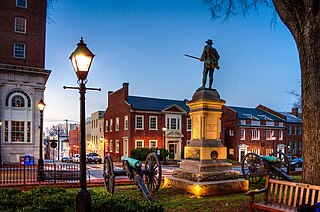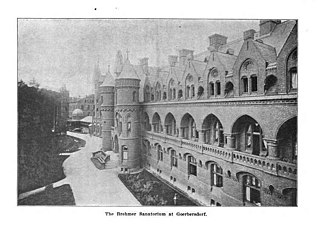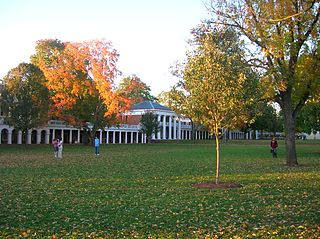
Charlottesville, colloquially known as C'ville, is an independent city in Virginia, United States. It is the seat of government of Albemarle County, which surrounds the city, though the two are separate legal entities. It is named after Queen Charlotte. At the 2020 census, the population of the city was 46,553. The Bureau of Economic Analysis combines the City of Charlottesville with Albemarle County for statistical purposes, bringing its population to approximately 160,000. Charlottesville is the heart of the Charlottesville metropolitan area, which includes Albemarle, Buckingham, Fluvanna, Greene, and Nelson counties.

A sanatorium, also sanitarium or sanitorium, are antiquated names for specialised hospitals, for the treatment of specific diseases, related ailments and convalescence. Sanatoriums are often in a healthy climate, usually in the countryside. The idea of healing was an important reason for the historical wave of establishments of sanatoriums, especially at the end of the 19th- and early 20th centuries. One sought, for instance, the healing of consumptives, especially tuberculosis or alcoholism, but also of more obscure addictions and longings of hysteria, masturbation, fatigue and emotional exhaustion. Facility operators were often charitable associations such as the Order of St. John and the newly founded social welfare insurance companies.

The Waverly Hills Sanatorium is a former sanatorium located in the Waverly Hills neighborhood of Louisville, Kentucky.
Piedmont Sanatorium was a rest home for tubercular African Americans in Burkeville, Virginia from 1917 to 1965. It was the first facility of its kind ever to be established in the United States. The Sanatorium later became the site of Piedmont Geriatric Hospital.
A preventorium was an institution or building for patients infected with tuberculosis who did not yet have an active form of the disease. Popular in the early 20th century, preventoria were designed to isolate these patients from uninfected individuals as well as patients who showed outward symptoms. Philanthropist Nathan Straus opened the first preventorium on Preventorium Road in Lakewood, New Jersey in 1909.

LeRoi Holloway Moore was an American saxophonist. He was a founding member of the Dave Matthews Band. Moore often arranged music for songs written by Dave Matthews. Moore also co-wrote many of the band's songs, notably "Too Much" and "Stay ".
David Wilfred Abse was a Welsh psychiatrist.

The Lawn, a part of Thomas Jefferson's Academical Village, is a large, terraced grassy court at the historic center of Jefferson's academic community at the University of Virginia. The Lawn and its surrounding buildings, designed by Jefferson, demonstrate Jefferson's mastery of Palladian and Neoclassical architecture, and the site has been recognized as an architectural masterpiece in itself. The Lawn has been designated a U.S. National Historic Landmark District, and is part of a UNESCO World Heritage Site along with the original buildings of the University of Virginia and Monticello, Jefferson's nearby residence; this designation is due to the site's architectural and cultural significance.

Muirdale Tuberculosis Sanatorium, also called Muirdale Tuberculosis Hospital, was built in 1914–15 by Milwaukee County, Wisconsin. It was located near the corner of Highway 100 and Watertown Plank Road in Wauwatosa and named after noted Wisconsin naturalist John Muir. Maximum capacity in 1923 was 350 patients, but in later years this figure rose to over 600, including a 100-bed Children's Cottage, or Preventorium, devoted to the treatment of young children.

University Hospital Hairmyres is a district general hospital in the Hairmyres neighbourhood of East Kilbride, South Lanarkshire, Scotland. The hospital serves one of the largest elderly populations in Scotland. It is managed by NHS Lanarkshire.

Vamık D. Volkan, M.D., DFLAPA, FACPsa, is a Turkish Cypriot psychiatrist, internationally known for his 40 years work bringing together conflictual groups for dialogue and mutual understanding. Among his many other honours, he is the president emeritus of International Dialogue Initiative (IDI).

Paul Goodloe McIntire (1860–1952) was an American stockbroker, investor, and philanthropist from Virginia. He served on the Chicago and New York Stock Exchanges. He was a generous donor to the University of Virginia and its home, the city of Charlottesville.

Zofiówka Sanatorium is a defunct mental health facility in the town of Otwock in Poland, built at the beginning of the 20th century. In the Second Polish Republic, the sanatorium complex was expanded with more buildings and staff. Zofiówka initially had 95 beds, but this number had increased to 275 by 1935. The Jewish history of Zofiówka came to its end in the course of the Holocaust following the invasion of Poland by Nazi Germany.
The town of Colorado Springs, Colorado, played an important role in the history of tuberculosis in the era before antituberculosis drugs and vaccines. Tuberculosis management before this era was difficult and often of limited effect. In the 19th century, a movement for tuberculosis treatment in hospital-like facilities called sanatoriums became prominent, especially in Europe and North America. Thus people sought tuberculosis treatment in Colorado Springs because of its dry climate and fresh mountain air. Some people stayed in boarding houses, while others sought the hospital-like facilities of sanatoriums. In the 1880s and 1890s, it is estimated that one-third of the people living in Colorado Springs had tuberculosis. The number of sanatoriums and hospitals increased into the twentieth century. During World War II, medicines were developed that successfully treated tuberculosis and by the late 1940s specialized tuberculosis treatment facilities were no longer needed.

The Oregon State Tuberculosis Hospital was a tuberculosis sanatorium in Salem, Oregon, United States. Established in 1905, it was the first public tuberculosis sanatorium on the West Coast. The main hospital building, constructed in 1894, had formerly housed the Oregon State Deaf-Mute School. After its conversion into the state tuberculosis hospital, multiple cottages and additional buildings were constructed on the property. The hospital remained in operation until 1969, when it was purchased by Corban University.

Ethan Allen School for Boys was a reform school in Delafield Town, Wisconsin which operated in a former tuberculosis sanitorium from April 1959 until June 2011, when it was abolished and the inmates moved to Lincoln Hills School in Irma. It was operated by the Wisconsin Department of Corrections.

Marcellus Eugene Wright Sr. was an American architect. He was active in Richmond, Virginia and the surrounding region during the first half of the 20th century. In addition to his work on hotels, Wright was a pioneer of the Moorish Revival architectural style in his design for the Altria Theater, which is a major component of the Monroe Park Historic District.

UVA Children's Hospital is a nationally ranked, acute care children's hospital in Charlottesville, Virginia. It is affiliated with the University of Virginia School of Medicine. The hospital features 112 pediatric beds. The hospital provides comprehensive pediatric specialties and subspecialties to infants, children, teens, and young adults aged 0–21 throughout the region. The hospital also sometimes treats adults that require pediatric care. The hospital has a rooftop helipad to transport critical pediatric cases. The hospital features a regional pediatric intensive-care unit and a level IV neonatal intensive care unit.

Tuberculosis Preventorium for Children in Lakewood Township, New Jersey was the first preventorium in the United States. It opened in July 1909, as an expression of Nathan Straus' desire to prevent the spread of tuberculosis among children. The children were selected mainly by the Association of Tuberculosis Clinics and were passed upon by the Department of Health of New York City. There were 32 of these clinics, to the nearest of which the parents applied. No discrimination was made as to race or creed, and there was no charge for transportation or board.

















